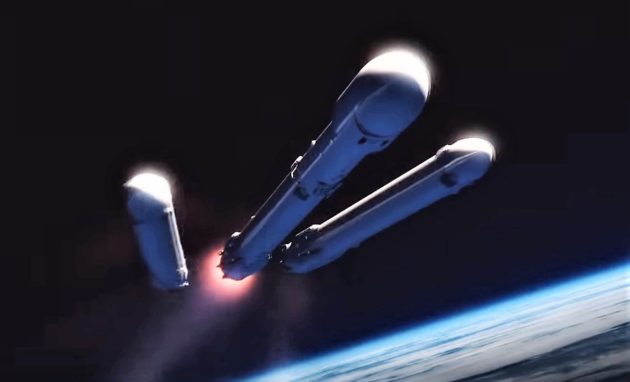
CAPE CANAVERAL, Fla. — Launching the Falcon Heavy rocket is arguably one of the riskiest operations that SpaceX has ever taken on, but billionaire CEO Elon Musk says he’s made his peace with the risks.
“Normally I feel super-stressed out the day before,” he told reporters today, on the eve of Tuesday’s first planned countdown for the massive, 230-foot-tall rocket. “This time I don’t. That may be a bad sign, I’m not sure. I feel quite giddy and happy, actually. … I’m sure we’ve done everything we could do to maximize the chance of success with this mission.”
If all goes well, SpaceX will demonstrate its ability to put hefty payloads into high Earth orbits, and potentially go well beyond Earth orbit. This time around, Musk is sending out a red Tesla Roadster with a dummy in the driver’s seat — but the same rocket power could be applied to more serious payloads such as spy satellites.
But all might not go well: Musk weighs the chances of complete success this first time around at about 50-50. During today’s teleconference, he listed five risky moments he’d be watching for during the flight.
- That 27-engine liftoff: The Falcon Heavy consists of three separate Falcon 9 rocket cores yoked together, and that means three sets of nine Merlin rocket engines have to work in concert. Musk said he worried about “the relative interaction of the three core boosters” — and the chance that resonant forces might knock them together with catastrophic results. “I would consider it a win if it just clears the pad and doesn’t blow the pad to smithereens,” he said.
- Going through Max-Q: A little more than a minute after launch, the rocket goes through maximum aerodynamic pressure, or Max-Q — when the forces acting on the rocket are the greatest. “That’s possibly where it could fail as well,” Musk said.
- Watch out for falling ice: The rocket’s three-part structure also raises the risk that ice knocked loose from the cryogenically chilled upper stage could strike the tops of the two side cores. “That would be like coming like a cannonball through the nose cone,” Musk said.
- Booster separation: Musk noted that the three-core booster separation system has been tested extensively on the ground, but never in flight. Separation should be complete a little more than three minutes after launch. “Once the second stage separates from the center booster, we are in much more known territory,” he said.
- Coasting through the radiation belt: The trajectory for this test flight is unusual in that it calls for a six-hour coast phase through the Van Allen radiation belt that encircles Earth. “It’s actually a radiation environment significantly worse than deep space,” Musk said. There’s a chance that the upper stage’s systems might not survive for the crucial engine burn that sends the Tesla out of Earth orbit. “It’s going to get whacked pretty hard,” Musk said.
On the plus side, Falcon Heavy’s success could revolutionize the heavy-lift launch market as much as SpaceX’s Falcon 9 has revolutionized more down-to-earth space missions.
The current base list price for a Falcon Heavy launch is $90 million, compared with $62 million for the Falcon 9. But Musk pointed out that if all three rocket cores can be recovered, the cost of flying the Falcon Heavy may end up being not that much more than the Falcon 9.
“If we are successful in that, then it’s ‘Game Over’ for all other heavy-lift rockets,” Musk said. “It would be like trying to sell an aircraft where one aircraft company had reusable aircraft, and all the other aircraft companies had aircraft that were single-use, and you parachuted out at your destination and the plane would crash-land randomly somewhere.”
Based on SpaceX’s production rate, Musk said Falcon Heavy rockets could be launched every three to six months. “Whatever the demand is, we’ll be able to meet it,” he said.
But Musk has come around to see the Falcon Heavy primarily as a transitional step to an even more powerful launch vehicle, known as the BFR (which stands for Big Falcon Rocket or Big F***ing Rocket, depending on how nasty you want to get).
“If we wanted to, we could actually add more two more side boosters and make it ‘Falcon Super-Heavy,’ and probably get thrust upwards of maybe 9 million pounds of thrust … but we think that the new BFR architecture is a better way to go,” he said.
Musk said the BFR is being designed with a reusable first-stage booster plus a reusable upper-stage spaceship, making it more economical than the Falcon Heavy. What’s more, the turnaround time for launches could be measured in terms of hours rather than days.
For that reason, SpaceX is putting an increasing amount of effort into the BFR.
“Our focus is on the ship,” Musk said, “and we expect to do, hopefully, short flights with the ship next year. That’s aspirational.”
Because of the timeline and the advantages of the BFR architecture, Musk is no longer expecting to send passengers on a trip around the moon using a Falcon Heavy. “That was our plan until last year, and then we thought, ‘Well, maybe we can make this BFR development go faster than we thought,'” he said.
If Musk’s vision becomes a reality as quickly as he hopes it does — which is always an iffy proposition — the next humans to get an up-close look at Musk’s Tesla Roadster in orbit may well be passengers following its tracks to Mars, but on a BFR spaceship.



